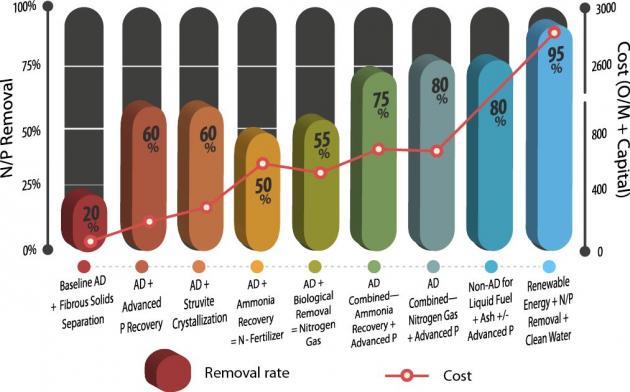Purpose
This presentation highlights existing and emerging recovery technologies that can be combined with energy recovery from dairy manure. A variety of technologies is in development, specifically tailored for solids, phosphorus, nitrogen, salt and combinations thereof. Data regarding estimated performance and cost as well as summary graphs are presented. Attention is focused on in-series treatment with anaerobic digesters, but mention is given to incorporation with other renewable energy/fuel technologies.
What did we do?
The presentation focused on information from pilot and commercial demonstration of nutrient recovery (NR) technologies, with sources including literature, pilot reports, company literature, project feasibility studies, and interviews. This presentation attempts to identify broad approaches, identify strengths and weaknesses of those approaches, as well as specific situations where each might be most appropriate. Individual case studies have been included so as to offer more detailed information about representative technologies.
What have we learned?
This presentation estimated a range of performance and cost achievements for each of these broad approaches to NR. Ranges are not necessarily indicative of individual technologies but rather represent an approximate average based on best available data in conjunction with some assumptions. Several factors made these performance and cost estimates challenging. In some cases, technologies are already operating in the dairy sector at commercial scale. In many cases, technologies are operating at a pre-commercial scale, or are used commercially in other sectors such as wastewater treatment facilities. This required assumptions to be made based on informed estimates. Also, because technologies are often applied within a single manure management system, it is clear that costs would vary significantly if applied in other situations. For example, an NR technology that operates well on dilute flush manure would likely require pretreatment at additional cost if applied to scraped manure. Finally, limited data were available, particularly in regard to costs. This is mostly due to proprietary concerns or unwillingness to cite specific costs due to rapidly changing technologies. These factors mean that performance and cost ranges should be viewed as “best estimates” based on the data currently available to researchers. It is meant to provide a broad view of the industry as a whole, and should not be used for individual technology purchase or investment decisions.

Future Plans
There are many other factors that will be important in developing the path forward for the dairy industry with respect to nutrient recovery, form and function of recovered nutrient products for example. Ongoing development of dairy NR technologies should therefore aim to develop products that fit seamlessly into existing fertilizer delivery systems while providing a form that meets transportation and market needs, at price points that are competitive with synthetic fertilizers. Development within such a competitive environment requires not only a sustained effort, but also national and capable partners, a lesson that has been identified during development of a market for high-value peat moss replacement from AD.
A look at the bigger picture, using analytical tools such as life cycle analysis, is also important. Comparison of the performance capabilities and costs of these two approaches are one point of comparison, but a more in-depth comparison may also include consideration of resource management and sustainability, including features such as energy balance, greenhouse gases, and eco-system benefits.
Authors
Jingwei Ma, Research associate at Washington State University mjw@wsu.edu
Craig Frear, Assistant Professor at Washington State University, Georgine Yorgey, Research associate at Washington State University, Chad Kruger, Director at Washington State University Center for Sustaining Agriculture & Natural Resources (CSANR)
Additional information
Acknowledgements
This research was supported by funding from USDA National Institute of Food and Agriculture, Contract #2012-6800219814; National Resources Conservation Service, Conservation Innovation Grants #69-3A75-10-152; Biomass Research Funds from the WSU Agricultural Research Center; the Washington State Department of Ecology, Waste 2 Resources Program; US Environmental Protection Agency Grant # RD-83556701; and the Water Environment Research Foundation.
The authors are solely responsible for the content of these proceedings. The technical information does not necessarily reflect the official position of the sponsoring agencies or institutions represented by planning committee members, and inclusion and distribution herein does not constitute an endorsement of views expressed by the same. Printed materials included herein are not refereed publications. Citations should appear as follows. EXAMPLE: Authors. 2015. Title of presentation. Waste to Worth: Spreading Science and Solutions. Seattle, WA. March 31-April 3, 2015. URL of this page. Accessed on: today’s date.

